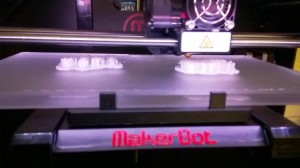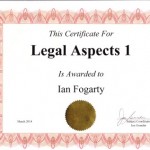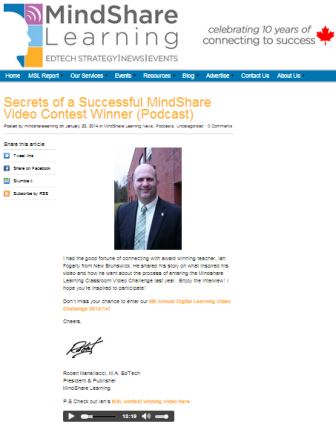Learn East 2014
I had a great time attending and speaking at Learn East 2014. It is full of teachers and administrators who give up their summer to be there at their own cost.
Spending time with Jeff Whipple and Bryan Facey are always so encouraging and inspirational. I feel like a better person just standing around them.
The highlight to me was Jacob Lingley’s Keynote about MakerSpace with Brilliant Labs and how we are starting to approach what was recently thought as Science fiction in Star Trek. I loved his definition of Maker Education as students interacting with technology to be creators and not just consumers. He then talked about how 3D printers, arduino, make-makey etch.. can be used to have students create.
I wonder if the participants saw it as a bit bigger school wide vision, more like Preston Middle School, where the school uses English, humanities, sciences, arts and engineering AND TECHNOLOGIES like 3D printers, arduinos, digital art, work, and iMovie to solve real problems for their real community. That is where the “A” (arts) and the “H”(humanities) are added to STEM to evolve into STEAM and SHTEAM.
Jacob’s talk setup my talk very nicely where I asked the question what school might look like if there were no classes for at least a little bit of the day. I then gave the Preston Middle School Animal Guzzler story, my Automated Greenhouse project from RHS Science 12 and my XenoTransplant project from RHS Science 12.
I did get a chance to catch a portion of a session about SMART Boards. It was FULL. It is technology that they all have but largely still do not know how to use. I thought my talk about high level SMARTBoard collaboration was over used at this conference and that participants would be bored. However, the Tech Mentor who was presenting on SMARTBOARDS was doing a good job demonstrating things like the Screen Shade, how to add a browser to the screen, how to make a my content folder. The teachers were eating it up.
Next year I will apply to give multiple sessions. Session #1. Document Camera’s and augmented reality with SmartBoards, Session #2 SmartBoards as Collaboration Hubs, Session #3 Workflow in small group work with SMartboards. This will combine the how, to use them, will give the tech mentors some space to do their things and then give them the “why” we should use them.
AMTEC Trust Fund through Canadian Network for Innovation in Education
I received notice that my newest research proposal will be partially funded by AMTEC Trust Fund through the Canadian Network for Innovation in Education.
The project looks to investigate the impact of 1:1 technology on student learning, work flow, communication and collaboration. This is a great step forward, as this grant is meant for university level research.
The recent flurry of recognition by a variety of organizations from Corporate to Research, (SMART, TELUS and AMTEC CNIE) is encouraging that I am on the right track. There is a critical mass growing to create something special, but we are not there yet. I need some more funding to upgrade aging tech, to help pay for third party participation to bring scientific credibility to the research, and to present the work academically and corporately. All this is important for our current and future students, it is outside of the mandate of public school system. I need a partnership. I need to find a PATRON. Any takers??
Telus Classroom Technology Grant
Yesterday, I was awarded one of the TELUS Classroom Technology Grants.
Ironically, I had applied for the grant to get a 3D printer, not knowing that SMART was also going to give me one. I think that there is enough work to go around that 2 printers will not be enough. It seems like there is a convergence of ideas happening. This is very exciting.
3D printer from SMART
2 weeks ago Smart donated a MakerBot 2 Replicator. Before I can figure out how a 3D printer might be useful in a chem, bio, physics, art class etch…I need to learn how to print. So for now, the learning will be about the details of how to print and what the capabilities are. Will it take many hours to learn to use the software? What kinds of parts are reasonable? Is learning how to use a 3D printer going to be a whole course all by itself? You do not have to know how an engine works to drive a car. How much of 3D printing do we need to know before we can make it useful for learning our various topics?
Is this a gimmick, or is it useful? At the moment, there is lots of excitement and lots of questions about how it works. There are lots of students who I have never seen showing up in my room. Students are going to get their friends and bringing them back to see it build. This is a fun first step.
I can’t wait until we are ready to take then next steps when we move from gimmick to innovation. .
It seemed fitting that one of the first things I print is a PEN for a SMARTBOARD. Turns out there is already a plan on Thingiverse for one. It works great on the old 600 capacitive series. Looking forward to trying it on the camera based boards.
The printer is doing multiple things at a time. Ends for a roof rack for the outdoor pursuits class, a bracket for a GPS unit for the upcoming outdoor pursuits bike trip, a cell phone case and a SMARTBOARD Pen.
About 2 hours into the 8 hour print, the filament fell out. I pushed it back in, but did not know how long it had been empty. Perhaps a layer or two. We decided to let it print anyway. It seemed to continue no problem. When we removed the items, there was a gap in the object. The printer printed almost into thin air. The connection was weak and it broke. However, we were able to use ABS cement on PLA plastics to glue ti back together.
Although this was a mistake, maybe it can print overhangs better than we think.
We needed a drain plug for our greenhouse. We could have gone to the local hardware store, but thought we should print instead. Again, we found this on Thingiverse. They worked like a charm.
Be side it is a mold of a lens for students to use on the presentation at the STEM Expo.
____________
So let’s try a molecule. Let’s try insulin. I found a pdb file for insulin, opened it in pymol, saved it as a V2RL file, opened that file in blender, saved it as a STL file. Then opened that in makerware. I chose to include raft and supports to make a 5 cm long model. I chose both the outer skin and the inside cartoon skeleton models. Print!!
This is the cartoon inside skeleton. It did the helix pretty well, but it is very thin. Pymol creates the cartoon model and has very thin connections representing the carbon chain from helix to helix. So when it printed on this scale the thin wires of carbon were not well done. I need to figure out how to “bold” the linking carbon chains. Double the scale will also help.
This is the outer skin of insulin on a raft and supports. The top looks a bit like a brain. The bottom is a bit hollow. After about 1.5 hrs of trying to clip off the supports, the bottom was still flat because of the supports. The supports were a real pain. If only they were dissolvable. I think a double headed extruder with a dissolvable filament would be very useful for chem.
#PreSES14 STEM Educator Symposium @ Preston Middle
This is the second time I attended the symposium. I was asked to give a keynote at the museum called “The School of Tomorrow looks like Kindergarten” as well as give a talk about the SMART Collaborative Classroom. I was able to contribute to a discussion about their new Collaborative Class. Although I built the first one, I am quickly falling behind because I do not have enough boards for all my students, the PCs that are running them cannot keep up with the new software and the in ability to be a google /smart amp school.
I find it fascinating that they have such a synergistic group of people running a national conference at a middle school. They are awesome!!
I learned from Scott and his team the value of bringing a team. He brought many people to Canada to see things in action and they were able to build something. Five people going to one conference is much better than 5 people going to 5 conferences. On our way home, I am sure we annoyed the rest of the passengers as we redesigned RHS grade 9 & 10. The timing is interesting in that we are in the middle of high school renewal with few concrete examples to follow. I wonder what will happen? Is this the start of the realization of my vision that I stole from others, (C21 Canada), of high school looking like Kindergarten.
I really loved getting to know all the people at Preston. Of particular note was a new person, Cathy Sampson. She came up to me to thank me for my Collaborative Class. She started to tear up. Later in the symposium, she showed what she was doing in her math class using “discourse”. It was I who got teary. She took what I did and went a step beyond. I loved watching her talk about what a negative sign meant to the student and wanted the student to record it in their journal. Very Fun.
I hope to return to Preston and I hope it will be with a team that will help transform our grade 9-10 classes.
I got to know Deena from SMART. I have met her quickly once before and exchanged lots of emails, but this was wonderful. It is unfortunate that she was so busy. She did not get to participate in the symposium as much as I think she would have wanted. I was really hoping she would see my talk on the SMART Collaborative Classroom because I have new material and I had teachers doing the “Alive or Not” project. Oh well, I did get to have supper with her and learn how to better interact with her and SMART.
The CEO of Agilent, an HP spin off, gave her talk just after mine at the museum. She crystalized many of the things I have been thinking for a while. Some examples include, “Culture eats strategy for Breakfast”.
Ethics in Research, Legal Aspects 1 & 2 Courses Completed
Over the past few months, I have been working on 3 courses.
- Ethics in Research from the University of Illinois at Urban-Champaign is an online course that is done through their consortium of universities for anyone doing IRB approved research.
- Legal Aspects 1 & 2 are modules working towards a New Brunswick Principal Certificate.
Pheasey Park Opens SCC and I chat with Shadow Ed Minister in UK.
Today, David and Gareth opened the FIRST SMART Collaborative Classroom in the UK. It was a pleasure to be a part of the day. The year 4 UK students gave their characteristics of “what is alive”, the last of 3 skype lessons between RHS in Canada and Pheasey Park in the UK.
I was honoured to answer a few questions about the technology. I was quick to talk about the PEDAGOGY that is now available because of the tech. Skype provides a world wide audience. The audience changes student attitude.”When I do it for my teacher, it just needs to be good enough, when I do it for the outside world it needs to be GOOD!”(Student quote from PRESES’13)
The SMARTBOARD provides a presence in the room during a SKYPE and provides a place for students to work together on this difficult question.
Math Collaboration…if it can happen here, it can happen anywhere!
I have been using my SMART Collaborative Classroom for a few years to help kids learn physics and chemistry while simultaneously teaching 21st Century Learning skills of Communication, Collaboration and Critical Thinking. This blog post is about a couple of math teachers who decided to try out the room. This is their first experience.
I had previously, but vaguely discussed how we use the SMARTBoards as student centered stations, where students work together to solve previously unseen questions. The day before March break, I was out of the room for the day and they decided it was a low enough risk to take a chance. Here is what they wrote to me afterwards.
“Complex word problems were posted on the SMARTboards. Students were grouped (3-5; more when both our classes were combined). There was NO learning curve for the students to use the SMARTboard. All groups, in all three classes I did this with, were fully engaged in problem-solving. Students had choice of problems (from easy to difficult). They were able to use various tools that the SMARTboard offers (ruler, graph paper background, compass, etc.) to try and solve their problems. When our combined classes were working together, students were sharing French-English math vocabulary, which is really important for my FI students to know they can do math in English. My biggest success story though is one of my SEP students who never talks. All I ever get out of him is a mumbled hello, yes or no. I have never seen him talk to any of the students in the class. But yesterday, his group was stuck trying to solve a problem so he took the lead, went up the board and started explaining his idea to the other students who were all listening very attentively. Following his sketches and explanations, the group successfully solved the problem. That was a significant breakthrough for him. When I have done the same activity in my class, with students sitting at desks with separate papers in front of them, he does not contribute to the discussions at all.
I hope we can do this again soon. The students loved it, and I loved listening to the intense math conversations I heard all around the room. Thank you again for letting me use your room, and all of its resources. I know you’ve worked hard to get them. “













